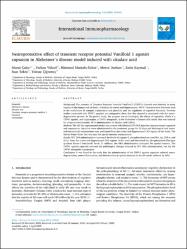| dc.contributor.author | Çakıl, Murat | |
| dc.contributor.author | Yüksel, Furkan | |
| dc.contributor.author | Özkut, Mahmud Mustafa | |
| dc.contributor.author | Durhan, Merve | |
| dc.contributor.author | Kaymak, Emin | |
| dc.contributor.author | Tekin, Suat | |
| dc.contributor.author | Çiğremiş, Yılmaz | |
| dc.date.accessioned | 2023-04-14T08:11:20Z | |
| dc.date.available | 2023-04-14T08:11:20Z | |
| dc.date.issued | 2023 | en_US |
| dc.identifier.citation | Çakır, M., Yüksel, F., Özkut, M. M., Durhan, M., Kaymak, E., Tekin, S., & Çiğremiş, Y. (2023). Neuroprotective effect of transient receptor potential Vanilloid 1 agonist capsaicin in Alzheimer’s disease model induced with okadaic acid. International Immunopharmacology, 118, 109925. | en_US |
| dc.identifier.issn | 1878-1705 | |
| dc.identifier.uri | https://dx.doi.org/10.1016/j.intimp.2023.109925. | |
| dc.identifier.uri | https://hdl.handle.net/20.500.12933/1451 | |
| dc.description.abstract | Background: The presence of Transient Receptor Potential Vanilloid 1 (TRPV1) channels was detected in many regions of the human and rat brain, including the cortex and hippocampus. TRPV1 channels have functions such as the modulation of synaptic transmission and plasticity and the regulation of cognitive functions. Previous studies conducted with TRPV1 agonists and antagonists show that this channel is associated with the neurodegenerative process. In the present study, the purpose was to investigate the effects of capsaicin, which is a TRPV1 agonist, and capsazepine, a TRPV1 antagonist, in the Alzheimer's Disease (AD) model that was induced by intracerebroventricular (ICV) administration of okadaic acid (OKA).
Methods: The AD-like experimental model was created with bilateral ICV OKA injection. Intraperitoneal capsaicin and capsazepine injections were administered to the treatment groups for 13 days and histological and immunohistochemical examinations were performed from the cortex and hippocampal CA3 regions of the brain. The Morris Water Maze Test was used for spatial memory measurement.
Results: ICV OKA administration increased the levels of caspase-3, phosphorylated-tau-(ser396), Aβ, TNF-α, and IL1-β, from the cortex and hippocampal CA3 regions of the brain and decreased the phosphorylated-Glycogen synthase kinase-3 beta-(ser9) levels. In addition, the OKA administration corrupted the spatial memory. The TRPV1 agonist capsaicin reversed the pathological changes induced by ICV OKA administration, but not the TRPV1 antagonist capsazepine.
Conclusions: It was found in the study that the administration of the TRPV1 agonist capsaicin reduced neurodegeneration, neuroinflammation, and deterioration in spatial memory in the AD model induced by OKA. | en_US |
| dc.language.iso | eng | en_US |
| dc.publisher | Elsevier Science | en_US |
| dc.relation.isversionof | 10.1016/j.intimp.2023.109925. | en_US |
| dc.rights | info:eu-repo/semantics/embargoedAccess | en_US |
| dc.subject | Alzheimer’s disease | en_US |
| dc.subject | Capsaicin | en_US |
| dc.subject | Capsazepine | en_US |
| dc.subject | Okadaic acid | en_US |
| dc.subject | Transient receptor potential vanilloid 1 | en_US |
| dc.title | Neuroprotective effect of transient receptor potential Vanilloid 1 agonist capsaicin in Alzheimer's disease model induced with okadaic acid | en_US |
| dc.type | article | en_US |
| dc.authorid | 0000-0001-8725-8909 | en_US |
| dc.department | AFSÜ, Tıp Fakültesi, Temel Tıp Bilimleri Bölümü, Histoloji ve Embriyoloji Ana Bilim Dalı | en_US |
| dc.contributor.institutionauthor | Özkut, Mahmud Mustafa | |
| dc.identifier.volume | 118 | en_US |
| dc.identifier.issue | 109925 | en_US |
| dc.relation.journal | International Immunopharmacology | en_US |
| dc.relation.publicationcategory | Makale - Ulusal Hakemli Dergi - Kurum Öğretim Elemanı | en_US |
















